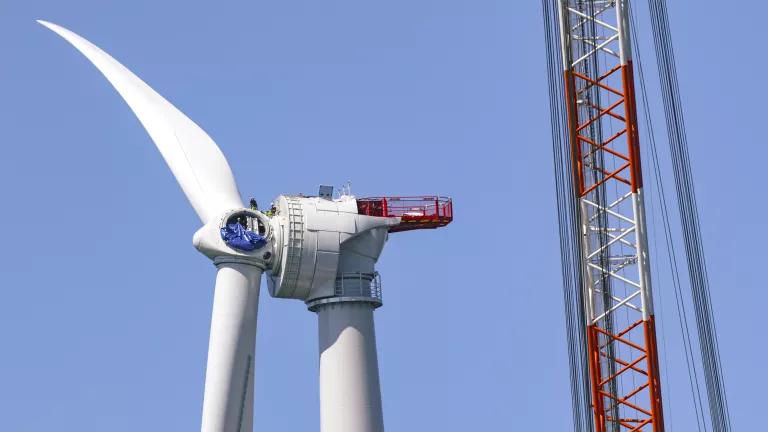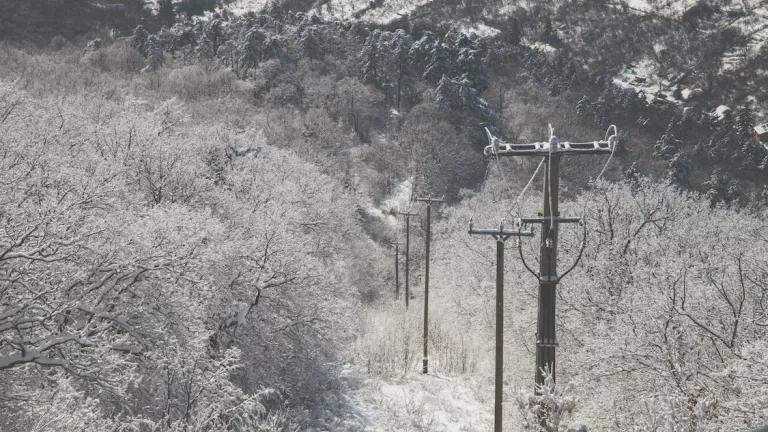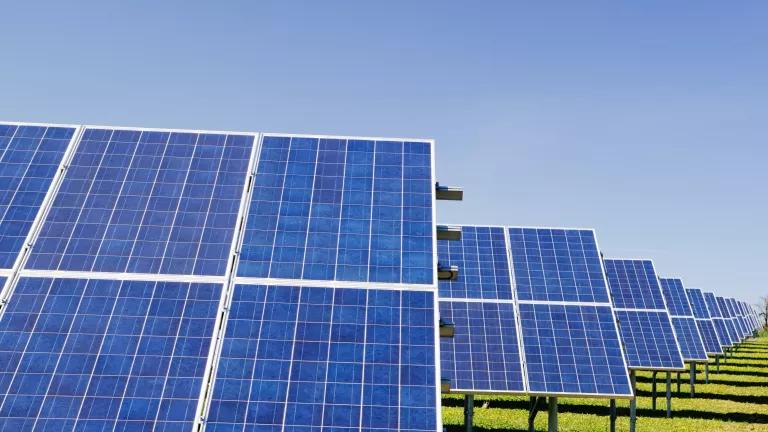DOE Report Provides a Road Map for Coordinated Offshore Transmission Planning
We need to start coordinated planning for an offshore wind network. This report charts a path for how to do it.

Workers on the nacelle of a turbine under construction on Block Island Wind Farm, September 14, 2016
UPDATE: On May 8, 2024, the U.S. Department of Energy (DOE) unveiled a preliminary list of potential National Interest Electric Transmission Corridors (NIETCs). Among these is a proposed 4-mile-wide, 12-mile-long corridor situated along the border between New York City and northern New Jersey. If approved, this NIETC could enhance interregional transmission between two neighboring RTO regions (NYISO and PJM), facilitating the integration of Atlantic offshore wind generation. If finalized, the corridor would encompass multiple potential onshore points of interconnection and sections of the Upper New York Bay.
NRDC advocates for the finalization of this NIETC to support the development of Atlantic offshore wind projects, enhance reliability and resilience, alleviate congestion, reduce consumer costs, and accommodate future generation and demand growth in the region.
Offshore wind holds immense potential to transform the nation’s energy landscape. By 2050, it could feasibly supply up to 25 percent of the country’s power, catalyzing a shift away from fossil fuels toward clean, renewable energy sources. Wind projects off the Atlantic Coast are spearheading this transition and are key to achieving a national target of 30 gigawatts of offshore wind energy by 2030, with an anticipated pathway to 110 gigawatts by 2050, which would be enough electricity to power 92 million homes. In addition to curbing greenhouse gas emissions and bolstering the resilience of electrical systems against extreme weather events, offshore wind power is poised to generate thousands of jobs and foster significant economic opportunities across various manufacturing and trade sectors.
Fully harnessing the vast potential of offshore wind energy hinges on the establishment of a robust offshore wind transmission network, which must include interregional connections to ensure that power can reach where it is most needed. This network is vital for efficiently delivering energy generated by offshore turbines to the onshore power grid. Moreover, adopting a coordinated approach to this build-out will yield cost savings and deliver important resiliency and reliability benefits. This week, the U.S. Department of Energy (DOE) released a long-awaited study, offering valuable insights into the design and structure of this essential transmission network.
Building transmission is hard, particularly offshore wind transmission
Transmission building has emerged as one of the most persistent obstacles hindering the transition to clean energy in the United States. Decades of neglect have left the U.S. power grid ill-equipped to accommodate the influx of new renewable energy sources such as wind, solar, and battery power. This grid strain not only creates uncertainty for developers but also threatens the reliability of the grid, particularly during severe weather events. Earlier this year, the Federal Energy Regulatory Commission (FERC) took a significant step forward by issuing Order 2023, marking the first major overhaul of how new power generation and battery storage will connect to the grid, over the next two decades. FERC is now on the brink of finalizing a rule that will address how regions should plan for the transmission infrastructure required to facilitate the rapid deployment of clean energy resources.
Addressing the transmission challenges associated with offshore wind presents an even greater obstacle. Unlike onshore transmission infrastructure, offshore wind projects currently lack access to an existing offshore transmission grid to connect to. While the absence of pre-existing infrastructure could be viewed as an advantage, there are unique hurdles associated with building a power grid in the ocean. These challenges include navigating complex environmental and regulatory considerations, addressing technical constraints, and ensuring the reliability and resilience of offshore transmission infrastructure.
Other challenges exist as well. Offshore wind farms are typically situated 10 miles or more from the coastline, requiring the transmission of power over even longer distances to reach onshore high-voltage transmission infrastructure that’s capable of managing substantial volumes of wind energy. Developers must navigate complicated permitting requirements that may span federal, state, and local jurisdictions. New lines may cross grid-planning regions, which will create issues over how these costs should be allocated.

The 2050 interregional topology with modeled cable routes
U.S. Department of Energy Atlantic Offshore Wind Transmission Study. Illustration by Billy Roberts, NREL
The scale of the challenge highlights the crucial need for coordinated action across multiple levels of government—state, regional, and federal. The current fragmented approach to offshore wind development, driven primarily by individual states, has led to numerous obstacles, as a study issued last year by the Brattle Group explains. These include delays in essential transmission line development, inefficient utilization of limited transmission corridors and interconnection points, and disparities in technical standards. It's clear that states alone lack the resources and capacity to address these challenges effectively. Therefore, coordinated action at the state, regional, and federal levels is essential. Such action would provide the necessary resources and regulatory framework to overcome hurdles and ensure the seamless integration of offshore wind energy into the nation's grid.
The DOE’s study provides a road map for how this offshore grid can be built. Specifically, it lays out a proposed sequencing plan for building interregional offshore wind transmission infrastructure from 2030 to 2050. In addition to radial designs for near-term projects, the study proposes four multiterminal (MT) high-voltage, direct-current (HVDC) interlinks, which would connect transmission planning regions and create opportunities to transfer up to 14 gigawatts of power between regions using the offshore network. Three of the proposed MT HVDC interlinks would connect the Independent System Operator (ISO) of New England, the New York Independent System Operator, and the PJM Interconnection. Additionally, one proposed MT HVDC interlink would connect the non-ISO/RTO (regional transmission organization) region of the Carolinas to PJM. The study finds that the benefits of building such a system outweigh the costs by nearly three to one.
In addition to the release of the DOE’s study on offshore wind transmission, the agency has also unveiled a companion action plan. This action plan outlines both immediate and longer-term efforts aimed at connecting the first generation of Atlantic offshore wind projects to the electrical grid and increasing transmission capacity over the coming decades. Immediate actions identified in the plan include:
- Establishing state and regional collaborative bodies spanning the Atlantic Coast region to facilitate coordination and planning efforts.
- Updating reliability standards and identifying potential interconnection points where offshore transmission can link with the onshore grid.
- Addressing cost considerations through voluntary cost allocation frameworks.
- Convening and coordinating with states and industry stakeholders to plan for the development of an offshore transmission network and standardizing requirements for HVDC technology.
Long-term actions outlined in the plan include:
- Establishment of a national HVDC testing and certification center to ensure compatibility when interconnecting multiple HVDC substations to form an offshore grid network.
- Codification of updates to transmission planning through regulated interregional joint planning, establishment of transfer capacity minimums, and implementation of market monitoring mechanisms.
NRDC and several partner organizations submitted a proposal to the DOE that the agency designate these interlinks as a National Interest Electric Transmission Corridor (NIETC). An NIETC is a geographic area, based on the findings of the DOE National Transmission Needs Study, where consumers are harmed by transmission gaps and where new transmission would provide additional benefits like improved reliability and affordability. This designation would have significant benefits, including unlocking essential federal financing for developers grappling with escalating costs and disruptions in the supply chain, which are impeding the progress of new projects. Additionally, it would provide resources to address interregional planning challenges, fostering collaboration and coordination among stakeholders to overcome barriers to offshore wind development.
Harnessing the vast potential of offshore wind energy is imperative for the United States to meet its environmental targets and enhance the resilience of our power grid amid escalating demand and more frequent occurrences of extreme weather events. As highlighted in the DOE study, proactive and coordinated interregional planning is crucial for minimizing environmental and community impacts associated with offshore wind development, expediting construction timelines, and ultimately reducing costs. By taking decisive action today to plan and invest in offshore wind infrastructure, we can pave the way for a cleaner, more sustainable energy future while strengthening the reliability and resilience of our nation’s power grid.


